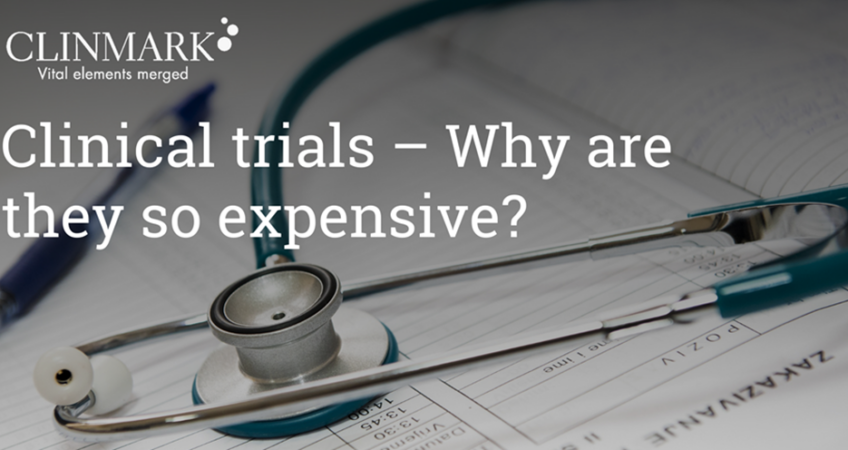Clinical trials – Why are they so expensive?

It’s a pretty common knowledge that clinical phase of drugs or medical device development is an expensive project. From drug development to medicinal product dossier submission to EMA or FDA, through investigative sites’ costs or implementation of IT solutions, the average product can mop up the millions of dollars by the time it obtains market authorization.
However, clinical trials are a vital part of drug development path as throughout this process, that happens outside the laboratory, the clinicians can investigate the efficacy and safety of the product as well as risks to benefit ratio in carefully selected patients’ populations.
When planning a clinical trial, one has to consider trial design, to develop the clinical study protocol, to plan countries and sites selection, details of trial execution, investigational product manufacturing and logistics, laboratories contracting, clinical trial supplies and samples logistics, IT systems implementation, regulatory affairs, project management, clinical trial data monitoring and management, biostatistics, pharmacovigilance and safety reporting, medical writing, quality control, and number of pass-through costs (e.g. investigative sites’ fee, costs of clinical procedures and tests, clinical trial’s insurance, etc).
One of the most popular numbers cited in pharma industry circles in recent years is $2.6 billion. That figure, originating from a 2014 study by the Tufts Center for the Study of Drug Development (CSDD), represents the cost of developing and gaining marketing approval for a new prescription drug.
That study, and its polarizing results, have been at the center of conversation in pharma during last several years. Fast forwarding to the present, a new study has emerged challenging previous findings on drug development cost.
The new study was conducted by a group of scientists from the non-profit Institute for Safe Medication Practices (ISMP). The group analysed data from 101 new drugs approved from 2015 to 2017. For the 225 individual trials reviewed, the study concluded the median cost of each was $19 million, with an interquartile range of $12 million to $33 million.
Data for the Tufts research was based on information provided by 10 pharmaceutical companies on 106 randomly selected drugs first tested in human subjects between 1995 and 2007. Factors cited in the report contributing to the $2.6 billion figure included more complex and extensive clinical trials and high failure rates for other drugs in testing. As noted, the Tufts study also factored in post-approval development costs.
In the new study by ISMP, costs per drug varied substantially among pivotal clinical trials that would lead to marketing approval. Overall, 45 of the 101 drugs analyzed were approved with a single trial, with a median cost of $28 million. For 29 of the reviewed treatments, the cost almost doubled when two trials were required, with a median of $45 million. The remaining 27 drugs were approved after three to 11 trials, at an estimated median cost of $91 million.
Another key factor that varied trial costs was respective therapeutic area, which according to the study, among the drugs analyzed, treatments varied from eye drops and skin creams to infusions and other intensive oncology treatments.
On the other hand according to research done by Food and Drug Administration (FDA) of the United States the average cost of phase 1, 2, and 3 clinical trials across therapeutic areas is around 4, 13, and 20 million USD respectively. Same studies show that new drug approved cost median per subject is around 40k USD.

The cost of a clinical trial depends on several factors, such as study size (number of patients), locations (number of countries), number of clinical sites, therapeutic area, drug type, and the specific tests and procedures needed per protocol, among other aspects.
The study size which in other words means number of patients to be recruited is closely related to the study phase. Early-phase (phase 1) trials require few patients (15-20 in average) while international phase 3 studies may involve hundreds of subjects (even thousands). Furthermore, academic and industry-led trials should be distinguished. Academic, not-for-profit sponsors may conduct trials without commercial interest, counting on less financial resources to cover trial activities. On the other hand, commercial sponsors have higher budgets to execute their drug development programs. Therefore, the clinical trial cost question does not have a single price answer. It really depends on the type, size, territory, and complexity of the research.
Although one simple answer to the question why clinical trials are so expensive may be difficult to find, we can try to define factors and services that are usually taken into consideration when planning such project. Most CRO quotations normally include the following cost sections:
- Regulatory affairs
- Site identification and selection
- Site contracting and payments
- Site initiation and activation
- Site management
- Onsite monitoring
- Drug safety management
- Drug logistics
- Biological sample logistics
- Clinical supplies logistics
- Medical writing
- Site close-out
- Project management
- Study files/document management
- Data management
- Statistics
- Quality control
- Communication with central CRO/sponsor
In summary the cost of a clinical trial depends on several factors, such as among the others, study design and ample size (number of patients) that is closely related to the study phase, therapeutic area, drug type, specific tests and procedures required by the protocol for efficacy and safety assessment, locations (number and the type of countries) or number of clinical sites. Therefore, the question about clinical trial cost does not have a single price answer. It really depends on the type, size, territory, and complexity of the research.
We can define top drivers of the clinical trials:
- Site monitoring costs – This has, historically, been a major burden for companies conducting clinical research. Fortunately, recent development of technology is working to lessen that burden.
- Patient recruitment and retention – As the use of new electronic systems and applications continues to rise, we may see patient recruitment and retention struggles begin to fall. A well-designed application can enhance the patient experience, thereby disincentivizing patient attrition.
